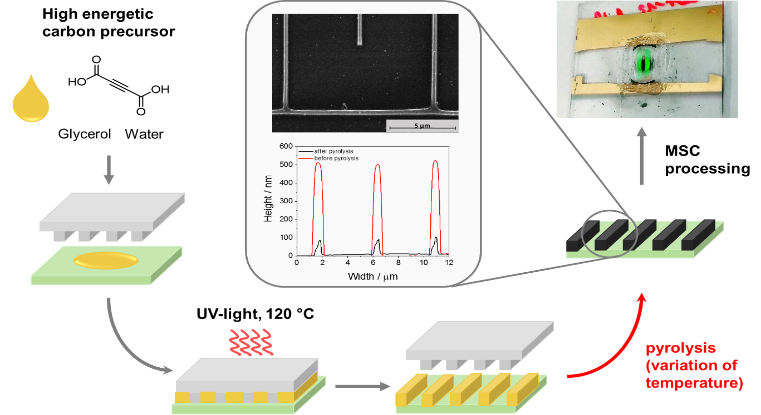Planar Carbon Lattices
RTG-2861-PCL
A4 - Precursor-derived printing of PCL electroadsorption devices
Principal investigator: Prof. Dr. Stefan Kaskel TU Dresden, [webpage]
Doctoral researcher in the 1st cohort: Aleena Jose
Doctoral researcher in the 2nd cohort: Open position
The integration of carbon materials into microdevices requires innovative deposition methods with low thermal processing load. Nanoimprinting is a versatile technology for nanostructuring[1] relying on the chemical development of curable PCL precursors with defined viscosity and surface interactions with substrate and the nanomold. Molecular carbon precursors are normally carbonized at high temperature above 800 K which limits their applicability in particular for polymeric substrates. In A4 we will develop new precursor methods for the synthesis of PCLs on surfaces. Nanoimprint technology will be used to print supercapacitor devices.[2] Tailoring of the carbon materials in terms of structure, conductivity and heteroatom content will be achieved in A4 by using 2D coordination polymer precursors containing highly labile organic or inorganic moieties for the thermal transformation into PCLs. The structure-property relationships for supercapacitor applications will be studied by analyzing their electrochemical performance.

Figure: Schematic procedure of the nanoimprint lithography process using a highly energetic carbon precursor for microsupercapacitor printing.
We develop synthetic approaches for PCLs under mild conditions for nanostructured supercapacitors based on soft lithography.[2]
Thesis topic 1st cohort: Synthesis of 2D carbon materials from highly reactive precursors
We will explore the synthesis of PCLs from reactive precursors. In particular, we will study the transformation of 2D coordination polymers containing highly reactive organic groups at liquid interfaces and on solid surfaces (see Figure).[3] The development of new chemical transformations for the generation of 2D materials with high electrical conductivity under mild conditions, i.e., below 373 K, is a key target. Ammonothermal treatment will be explored to achieve post-functionalization with redox-active N-sites and isotope labelling. Nanoimprint technology will be used for making structured devices. We also study the post-synthetic doping of 2D materials via gas phase reactions such as ammonolysis.
Thesis topic 2nd cohort: Microstructured PCL-based electroadsorption devices
[2] S. Lochmann, Y. Bräuniger, V. Gottsmann, L. Galle, J. Grothe, S. Kaskel, Switchable Supercapacitors with Transistor‐Like Gating Characteristics (G‐Cap), Adv. Funct. Mater. 2020, 30, 1910439.
[3] C. Gellrich, S. Lochmann, T. Otto, J. Grothe, S. Kaskel, Mater. Adv. 2021, 2, 6380.
